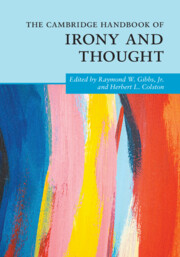Book contents
- The Cambridge Handbook of Irony and Thought
- Cambridge Handbooks in Psychology
- The Cambridge Handbook of Irony and Thought
- Copyright page
- Contents
- Contributors
- Part I Introduction
- Part II The Scope of Irony
- 2 Kinds of Irony: A General Theory
- 3 Irony and Cognitive Operations
- 4 The Varieties of Ironic Experience
- Part III Irony’s Impact
- Part IV Irony in Linguistic Communication
- Part V Irony, Affect, and Related Figures
- Part VI Irony in Expressive, Nonlinguistic Media
- Index
- References
3 - Irony and Cognitive Operations
from Part II - The Scope of Irony
Published online by Cambridge University Press: 20 December 2023
- The Cambridge Handbook of Irony and Thought
- Cambridge Handbooks in Psychology
- The Cambridge Handbook of Irony and Thought
- Copyright page
- Contents
- Contributors
- Part I Introduction
- Part II The Scope of Irony
- 2 Kinds of Irony: A General Theory
- 3 Irony and Cognitive Operations
- 4 The Varieties of Ironic Experience
- Part III Irony’s Impact
- Part IV Irony in Linguistic Communication
- Part V Irony, Affect, and Related Figures
- Part VI Irony in Expressive, Nonlinguistic Media
- Index
- References
Summary
Irony is a complex phenomenon that may rely on several different forms of thought which are routinely relied on in verbal and nonverbal communication. This chapter outlines a theory of the “cognitive operations” that underlie the possible production and understanding of ironic meaning. These cognitive operations (e.g., strengthening and mitigation, expansion and reduction) are critical in the expression and interpretation of many figures of speech (e.g., metaphor, metonymy) and may provide the basis for a more general theory of meaning construction. Mendoza Ibáñez focuses primarily in this chapter, however, on ironic echoing, which allows speakers to pretend to be in agreement with some previously stated utterance or presumed thought. He considers many of the formal complexities of ironic echoing to demonstrate their varying, often subtle, communicative effects. His analysis also suggests how attention to cognitive operations may provide the theoretical basis for unifying verbal and situational irony.
Keywords
- Type
- Chapter
- Information
- The Cambridge Handbook of Irony and Thought , pp. 38 - 59Publisher: Cambridge University PressPrint publication year: 2023



